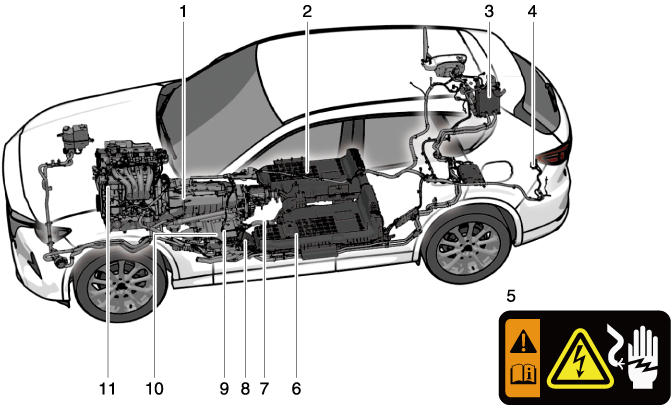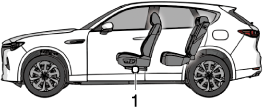e-SKYACTIV PHEV
e-SKYACTIV PHEV
The e-SKYACTIV PHEV is a hybrid system with the ability to recharge the battery from an external power supply, and achieves both excellent fuel economy and power performance by efficiently combining EV driving, which runs solely on electricity, and driving using both the engine and motor.
The e-SKYACTIV PHEV can supply power stored in the high voltage battery to electrical appliances.
Refer to AC Power Outlet (120 V/1,500 W) (Search).
e-SKYACTIV PHEV Overview

-
Engine
-
Motor and regenerative braking
-
High voltage battery
-
Charge port
-
AC Power Outlet (120 V/1,500 W)
-
Approaching vehicle audible system
Engine
Depending on the driving condition and driving mode, the engine operates as a power source or generator for the wheels, and stops when power or power generation is not required.
Motor
The motor transmits the motor power to the wheels using the electrical power of the high voltage battery.
Regenerative Braking
Regenerative braking uses the motor to decelerate the vehicle. Power is generated by the wheels rotating the motor while decelerating and the generated power charges the high voltage battery.
High Voltage Battery
The high voltage battery is a large-capacity battery and stores the charged power and the electrical power generated by regenerative braking.
Charge port
The charge port connects the charge connector of the charge cable and charges the high voltage battery with power from an external power supply.
AC Power Outlet (120 V/1,500 W) (Some Models)
The AC power outlet (120 V/1,500 W) provides power for household electrical appliances while the vehicle power is switched ON (hybrid system off).
Approaching Vehicle Audible System
The approaching vehicle audible system notifies pedestrians of the vehicle approaching using a warning sound while driving at low speeds.
Warning and Cautions for Using the e-SKYACTIV PHEV
The hybrid system has high voltage areas and high temperature areas. Labels indicating the cautions on use are applied to these areas. Always follow the instructions on the label and use the vehicle correctly.
Be very careful of high voltage areas. In addition, do not disassemble, modify, or remove any high voltage parts.
The following areas contain high voltage parts and may cause electrical shock if touched.

-
Motor
-
High voltage battery
-
Onboard charger
-
AC Power Outlet (120 V/1,500 W)
-
Warning label example
-
Service plug
-
High voltage cable
-
Water heater
-
Inverter
-
DC-DC converter
-
Electric compressor
Be very careful of high temperature areas.
The hybrid system and the engine become hot when they operate. Follow the instructions on the label attached to the vehicle and always pay attention to high voltage areas and high temperature areas.
Do not touch the service plug.
A service plug is installed in the high voltage battery. This service plug is used at an Authorized Mazda Dealer when repairing vehicles in order to cut off the high voltage of the high voltage battery. Do not touch the service plug. If you handle the service plug mistakenly, it could lead to an electrical shock causing serious injury or death.

-
Service plug
Maintenance and Repairs
For vehicle maintenance or repairs, consult an Authorized Mazda Dealer.
Technical knowledge and skill are necessary in handling the high voltage battery.
To ensure safe and correct handling of the high voltage battery, always heed the following precautions.
-
Do not remove the high voltage battery.
-
Do not resell, transfer, or modify the high voltage battery.
-
Do not make secondary use of the high voltage battery.
If the drive battery is not handled properly, the following may occur which could lead to serious injury or death.
-
Touching an unattended high voltage battery may cause an electric shock.
-
If the high voltage battery is used on a vehicle other than the one it came equipped on (including modified vehicles), accidents such as electric shock, heat generation, smoking, combustion, and explosions, or an electrolyte leakage may occur.
Heed the following instructions to prevent deterioration of the high voltage battery or damage to the high voltage battery.
-
Do not leave the vehicle for a long time under extremely high or low temperature conditions.
-
Do not leave the vehicle for 14 days or longer while the high voltage battery power gauge is at Empty (level 0).
If an Accident Occurs
Heed the following cautions to prevent serious injury such as electric shock, or in the worst case death.
Do not continue to drive the vehicle.
To prevent further accidents, stop the vehicle in a safe place, shift the selector lever to the P position, and then apply the parking brake to stop the hybrid system.
Never touch electrical wiring that may be protruding into or outside of the cabin.
Otherwise, it could result in electrical shock and serious injury.
Never touch any area where electrolyte is visible or electrolyte is leaking from the area.
If electrolyte from the high voltage battery gets in the eyes or on the skin, it could cause loss of vision or skin reactions. If electrolyte comes into contact with the eyes, do not rub them, and after flushing with water for 15 minutes or longer, seek medical attention immediately. In addition, if electrolyte comes into contact with the skin, wash the areas with soap and water thoroughly. If you feel any abnormality in your body, seek medical attention immediately.
Never approach objects that are on fire or extremely hot.
Electrolyte in the high voltage battery may cause a fire. If the vehicle catches fire, extinguish the fire using a fire extinguisher (type ABC, BC, or C). Only extinguish a fire with water when a large amount of water is available such as from a fire hydrant. Using a small amount of water may cause the fire to spread.
Do not tow the vehicle with the front wheels or the rear wheels grounded.
Otherwise, the motor generates electricity which may cause a fire depending on the condition of the damage. When towing the vehicle, tow it with all 4 wheels off the ground.
Do not start the hybrid system if there is liquid leaking from the vehicle (other than air conditioner water).
If liquid leakage (other than air conditioner water) is found on the road surface under the vehicle, the fuel system may be damaged. Starting the hybrid system in this condition, may cause a fire. Do not start the hybrid system and contact an Authorized Mazda Dealer.
Scrapping Your Vehicle and Disposing of High Voltage Battery
The high voltage battery is collected to prevent accidents involving it. When scrapping your vehicle, replacing the high voltage battery, or disposing of the high voltage battery, consult an Authorized Mazda Dealer. Please cooperate in ensuring that the vehicle's high voltage battery is collected.
Appropriate disposal of the high voltage battery.
If the high voltage battery is not collected and disposed of appropriately, such as by leaving it unattended or illegally abandoning it, some other person may touch it which could cause electrocution leading to serious injury.
Fuel
-
The e-SKYACTIV PHEV can be driven on electricity, but depending on the driving conditions and mode, the vehicle will be driven using the engine and will need to be refueled. Check the remaining amount of fuel and replenish the fuel if necessary.
Refer to How to Use the Mazda intelligent Drive Select (Mi-Drive) (Search).
-
Depending on the vehicle usage conditions, fuel may remain in the tank for a long period of time and the quality of the fuel may change. Refuel at least 25 L of fuel every 12 months (total amount of refueling for 12 months is at least 25 L), as this may affect parts of the fuel system and the engine.
-
If the fuel has not been replenished for a certain period of time and the quality of the fuel in the fuel tank is expected to change, a message is displayed in the instrument cluster when the hybrid system is started. When a certain amount of fuel is consumed, the message displayed in the instrument cluster is no longer displayed.
Convenient Ways to Use the e-SKYACTIV PHEV
Switch to Start in EV Mode
The hybrid system can be changed to start in EV mode.
Refer to the Mazda Connect Owner's Manual or consult an Authorized Mazda Dealer.
Switching the Regenerative Braking Strength
The regenerative braking strength can be changed.
Refer to the Mazda Connect Owner's Manual or consult an Authorized Mazda Dealer.
For Eco-Friendly and Economical Driving
Using the Drive Mode
EV mode is mainly used in urban areas, while NORMAL mode is used in suburban areas and on expressways, which leads to savings in electricity and fuel consumption.
By actively using regenerative braking to charge the high voltage battery, it is possible to increase the EV travel distance and to reduce fuel consumption when driving the vehicle in a mode other than EV mode.
To extend cruising distance
The electrical power consumption while driving can be reduced and the cruising distance can be extended by doing the following operations.
-
With the charge connector connected, turn on the climate control system to provide a comfortable temperature in the cabin before driving.
-
When driving during cold temperatures, use the seat warmer or steering warmer instead of the climate control system.
-
Adjust the climate control system to a moderate airflow and temperature setting.
-
Refrain from using the defogger under conditions other than when a window is fogged or frozen.
-
By maintaining a sufficient distance between vehicles and using the regenerative braking well, more electrical power can be charged to the high voltage battery.
To extend the life of the high voltage battery
The high voltage battery life changes depending on the vehicle storage conditions or charging method.
To extend the life of the high voltage battery, be careful of the following.
(Charging the battery)
-
Avoid unnecessary, frequent charging.
-
Only charge the battery with as much power as needed, and do not always fully charge the battery. The maximum charge limit can be set.
Refer to Convenient Ways to Use of Charging (Search).
(Parking the vehicle)
-
Do not park the vehicle in a place where the ambient temperature is extremely high or low.
-
Do not leave the vehicle while the remaining high voltage battery power is extremely low.
-
If the [Battery Cooling] operation notification is displayed on the center display after driving the vehicle, select [Activate].
Remaining Charge and Temperature of the High Voltage Battery
If the high voltage battery level is low or the high voltage battery temperature is not appropriate, the vehicle speed may not increase even if the accelerator pedal is depressed because the motor output is restricted. If the high voltage battery temperature is not appropriate, the high voltage battery temperature warning light  in the instrument cluster turns on. Check the contents displayed in the instrument cluster and the remaining amount of power in the high voltage battery before driving.
in the instrument cluster turns on. Check the contents displayed in the instrument cluster and the remaining amount of power in the high voltage battery before driving.
(Battery cooling)
If the high voltage battery temperature is high after driving the vehicle, it is possible to cool the high voltage battery while the vehicle is parked to extend the life of the high voltage battery. If the Excessive Battery Temperature notification is displayed on the center display after driving the vehicle, select Start to start the battery cooling.
Because the electrical power of the high voltage battery is used by the battery cooling, we recommend that the charge connector is connected while the battery cooling is operating.
















































